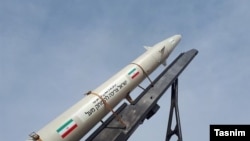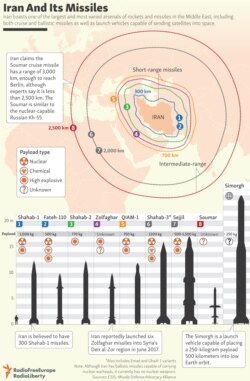Tehran is showcasing what the Islamic Republic's supporters dub as "achievements" that ensure its "independence and progress" as the Islamic revolution's 41st anniversary approaches on February 11.
During the days ahead of the anniversary the state TV features images of inauguration of dams, covering dirt roads with tarmac, or erecting telecommunication towers.
During recent days, state officials have been talking about the imminent launch of Zafar [Victory] satellite and made a lot of fuss about the launch no one knows when it will exactly take place.
The 113 Kg satellite is to be put on an orbit some 530 Kilometers high above the Earth, the Iranian media say.
Officials at the Iranian Ministry of Information Technology and Communications (ITC) say it took 80 Iranian engineers three years to build the satellite which is to be launched into space with a Simorgh satellite carrier missile. Simorgh is the name of a legendary bird in the Persian epic Shahnameh or the Book of Kings.
Iran's space program dates back to a few years before the 1979 Islamic revolution that replaced an millennia-old monarchy with a fundamentalist anti-U.S. clerical government.
Plans made in 1977 were supposed to be completed in 1982 for the launch of a satellite called Zohreh [Venus] which was to boost the coverage of the National Iranian Radio Television (NIRT).
Like many other modernization and scientific development projects, the plan was suspended indefinitely by the clerics who took over Iran and halted the country’s space and nuclear programs, among many other ambitious plans.
In 1982, the International Telecommunication Union (ITU) notified Iran that it was going to lose the orbit slot allocated to it if it did not have a satellite ready for launch or was not able to buy or rent an old one to put in orbit. Apparently, Iran did not have any plans to put a satellite in orbit and the issue died.
Iran was unable to act also because many of its experts had left the country or were jailed or even executed for political reasons. The only solution for Tehran was to lease aging Russian satellites and preserve its slots on the orbit in a patchy way. But this cost Tehran some $20 million.
Nevertheless, what happened was not unexpected as Iran's space program had fallen victim to the naïve revolutionary and so-called jihadi management signified by inefficiency.
Some fifteen years ago, Iran developed a new micro-satellite in collaboration with Italian companies which was supposed to be launched in 2005 with the Russian missile Kosmos-3M. However, the costly project failed and was shelved forever. The reason: International sanctions.
In the same year, Iran signed a $132 million contract with a Russian company to Launch Zohreh, using French and German equipment. The deal to build the Zohreh 1 (Venus) satellite was signed with the Russian Aerospace Agency and its affiliate AviaExport in 2005. The contract was to continue with building Zohreh 2 satellite, but it was cancelled later.
Finally, Iran began working on developing its own satellites and launch vehicles. In January 2019, reports indicated that Iran had three failed attempts to launch satellites including Payam into orbit, but was still trying to plan another launch.
In August 2019 President Donald Trump posted a photo via Twitter of Iran's Imam Khomeini Space Center in Semnan, 219 kilometers (136 miles) southeast of the capital city, Tehran.
The satellite image showed the damage done to the facility by the explosion of what appears to have been a homemade "Safir" rocket during launch. Apparently, the rocket was being used in the attempted launch of Iran's Nahid-1 satellite.
In a later tweet Trump underlined that the U.S. was not involved in the incident. The disclaimer comes on the backdrop of well-known cyber efforts by the United States to disrupt Iran's nuclear and missile programs; not only during the Trump administration but starting years earlier.
However, Iranian Minister of Information and Communications Technology Mohammad Javad Azari Jahromi on Saturday, August 30 showed Nahid 1 (Venus 1) telecommunication satellite to journalists but did not elaborate further on the spacecraft's failed launch.
The United States charges that the satellite carrier Simorgh rocket Iran showcased on February 4,2019 is part of Iran's ballistic missile program rather than being part of a peaceful telecommunication project.
The United States has accused Iran of flouting a United Nations Security Council resolution by launching its most advanced satellite-carrying rocket to date. U.S. State Department spokeswoman Heather Nauert in July last year said the "provocative act" also violates the "spirit" of Tehran's 2015 nuclear agreement with world powers.
"We consider that to be continued ballistic-missile development," Nauert said.
Iranian state television showed footage of the Simurgh (Phoenix) rocket being launched carrying pictures of Ayatollah Ruhollah Khomeini and said the rocket can put a 250-kilogram satellite into an orbit 500 kilometers high.
The State Department said that type of technology is inherently designed to carry a nuclear payload, and Pentagon officials have said the technology can be used to develop long-range intercontinental ballistic missiles.







